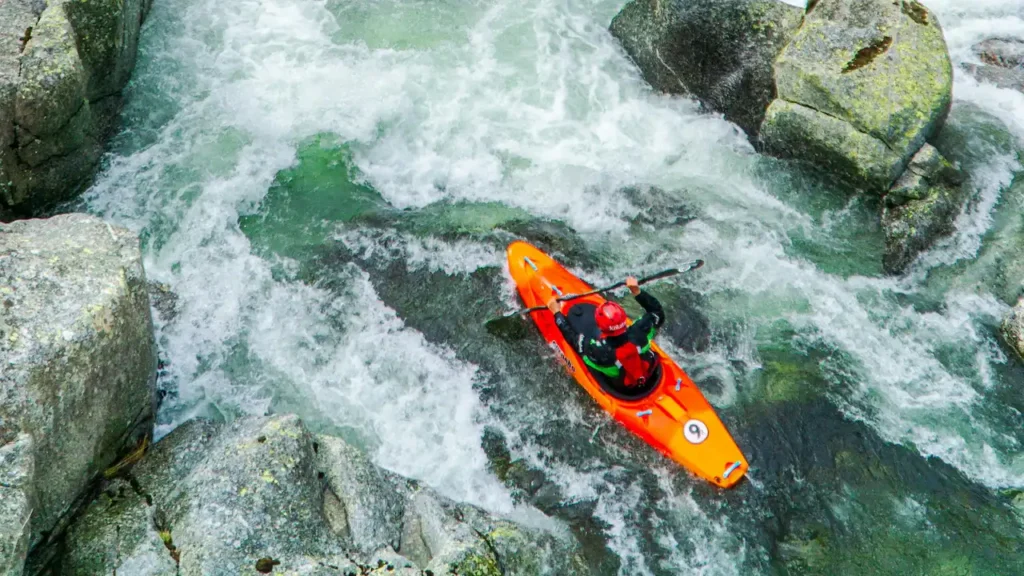Sit-on-top kayaks are an excellent choice for paddlers. These kayaks are popular for recreational kayaking, fishing, and touring because of their stability, ease of use, and comfort. You need the right gear for an improved experience. In this guide, we’ll explore the must-have accessories for sit-on-top kayaking adventures. These accessories will equip you for smooth paddling, exciting exploration, and unforgettable moments on the water.
Sit-On-Top Kayak Seats & Backrests
Selecting the right seat and backrest can significantly enhance your kayaking experience.
Types of Sit-On-Top Kayak Seats & Backrests
Basic Padded Seats:
Provide minimal padding.
Ideal for short trips or casual use.
Lightweight and affordable.
Deluxe Cushioned Seats:
Offer thick foam padding for improved comfort.
Adjustable backrests for better lumbar support.
Suitable for longer kayaking sessions.
High-Back Seats:
Provide extended back support.
Ideal for taller paddlers or those with back issues.
Often used for fishing kayaks or touring.
Gel-Padded Seats:
Contour to your body for superior comfort.
Absorb shocks from waves or uneven water surfaces.
Great for extended use or rough water.
Fishing-Specific Seats:
Designed with additional support and storage.
Often have rod holders, tackle storage, and accessory loops.
Inflatable Seats:
Lightweight and easy to transport.
Provide customizable firmness.
Ideal for portability.
Key Features to Look For
Adjustability: Look for adjustable straps to fine-tune the seat’s position and angle. This ensures proper posture and reduces fatigue.
Durable Material: Look for UV-resistant, marine-grade fabrics. Thies ensure rust-proof hardware for saltwater conditions.
Non-Slip Base: This Keeps the seat securely in place during use. This is important for stability in rough conditions.
Drainage: Look for perforated materials. Perforated or quick-dry materials prevent water from pooling. This Keeps the seat lightweight and comfortable.
Attachment System: Ensure compatibility with your kayak’s attachment points or D-rings. Some seats come with universal fittings.
Portability: Go for lightweight design. Lightweight and foldable designs are easier to carry and store.
Sit-On-Top Kayak Paddle Leashes
A paddle leash is an essential accessory for sit-on-top kayak paddlers. This ensures paddle remains secured to your kayak even if you accidentally let go. This simple but effective tool provides peace of mind, especially in rough waters or during fishing trips where your hands might be occupied. Here’s an overview of paddle leashes for sit-on-top kayaks:
Types of Paddle Leashes
Coiled Leashes:
Compact and stretchable.
Minimize tangling and are easy to manage.
Ideal for those who want a low-profile leash.
Straight Leashes:
Simpler design, often made from bungee cord or rope.
More prone to tangling but very durable.
Suitable for casual paddling and fishing.
Velcro Attachment Leashes:
Use velcro straps to attach to the paddle shaft.
Adjustable and easy to install.
Good for paddlers who switch between different paddle sizes.
Clip-On Leashes:
Feature carabiner clips for quick attachment to the kayak.
Convenient and versatile.
Perfect for paddlers who need fast setup and removal.
Retractable Leashes:
Spring-loaded mechanism keeps the leash taut when not in use.
Prevents dragging or tangling.
Best for those who want minimal interference while paddling.
Features to Consider in Kayak Leashes
Material Durability: Opt for marine-grade materials that resist UV rays, saltwater, and wear. Bungee cords, nylon webbing, and TPU are common choices.
Length: Ensure the leash is long enough to allow full paddle movement. But don’t go for a very long one. This could be a hazard then.
Attachment Points: Check compatibility with your paddle and kayak. Most leashes attach to the paddle shaft and kayak via D-rings and pad eyes.
Ease of Use: Go for quick-attach mechanisms.
Tangle Resistance: Coiled or retractable designs are less likely to tangle.
Weight: Lightweight leashes are less likely to interfere with paddling.
Scupper Stoppers for Sit On Top Kayaks
Scupper stoppers or scupper plugs are essential accessories for sit-on-top kayaks. They are designed to block the scupper holes in your kayak. This helps to manage water flow and keeps your seating area dry.
Scupper stoppers are made from rubber, silicone, or foam.
Benefits of Using Scupper Stoppers
Prevent water from splashing in through the scupper holes.
Ideal for colder weather.
Keeps the seating area dry.
Can be inserted or removed when necessary.
Types of Scupper Stoppers
Universal Scupper Plugs:
Designed to fit a range of scupper hole sizes.
Made from flexible materials like rubber or silicone.
Brand-Specific Scupper Plugs:
Tailored for specific kayak models and brands e.g., Hobie, Perception, and Wilderness Systems.
Provide a precise fit for optimal performance.
Push-In Style:
Tapered design that you push into the scupper hole.
Easy to install and remove.
Threaded Scupper Plugs:
Twist-in design for a secure fit.
Common in some premium kayak brands.
Foam Scupper Plugs:
Lightweight and compressible.
Affordable but may not be as durable as rubber or silicone options.
Key Features to Look For
Size Compatibility: Measure the diameter of your scupper holes before purchasing. Many plugs are available in specific sizes and adjustable designs.
Material Quality: Choose UV-resistant and waterproof materials for durability. Silicone and rubber are great for flexibility and a watertight seal.
Ease of Use: Opt for designs with pull tabs or handles for easy insertion and removal.
Drainage Control: Some plugs allow partial drainage, giving you the best of both worlds.
Sit-on-Top Kayak Fishing Rod Holders
Fishing rod holders are essential for sit-on-top kayak anglers. It provides hands-free convenience. They come in various designs to fit different fishing styles, rod types, and kayak configurations.
Types of Kayak Fishing Rod Holders
Flush Mount Rod Holders:
Built into the kayak deck, offering a low-profile design.
Provide a fixed, upright rod position.
Ideal for trolling or keeping rods out of the way.
Often require drilling for installation.
Deck-Mounted Rod Holders:
Attached to the deck using screws or adhesive mounts.
Adjustable angles for better positioning.
Great for anglers who need versatility.
Clamp-On Rod Holders:
Attach to the kayak’s edges or gunwales with clamps.
Easy to install and remove, requiring no drilling.
Ideal for temporary setups or rental kayaks.
Track-Mounted Rod Holders:
Compatible with kayaks that have built-in gear tracks.
Slide and lock into position for easy adjustment.
Excellent for modular and customizable setups.
Crate or Cooler Rod Holders:
Attach to a fishing crate or cooler.
Provide additional storage without taking up deck space.
Ideal for kayaks with limited mounting options.
Magnetic or Suction Rod Holders:
Use magnets or suction cups for mounting.
Non-permanent and easy to reposition.
Best suited for calm waters or light-duty use.
Key Features to Look For
Adjustability: Choose rod holders with adjustable angles for precise rod positioning. Look for 360-degree rotation for maximum flexibility.
Material Quality: Opt for marine-grade materials like stainless steel or heavy-duty plastic. Ensure UV and corrosion resistance for durability in harsh conditions.
Ease of Installation: Consider whether you want a permanent or temporary solution. Choose clamp or suction for an instant solution. You can drill for a permanent installation.
Rod Compatibility: Ensure the holder can accommodate the type and size of your fishing rods.
Stability and Security: Look for rod holders with locking mechanisms to prevent accidental loss. Ensure they remain stable during paddling and casting.
Accessories and Add-Ons: Some rod holders come with cup holders, gear trays, or built-in leashes.
Sit-On-Top Accessory Mounts & Bases
Accessory mounts and bases enable you to attach various tools and equipment, such as fish finders, cameras, rod holders, GPS devices, and cup holders. Choosing the right mounts and bases enhances your kayak’s experience.
Types of Accessory Mounts & Bases
Track Mounts: Long, narrow tracks installed on the kayak’s deck. These mounts attach multiple accessories like rod holders, camera mounts, and cup holders. Theu allow sliding and repositioning of accessories.
Screw-In or Bolt-On Bases: Fixed bases that are drilled and mounted permanently onto the kayak. They securely hold rod holders, anchor trolleys, and fish finders. They are extremely stable and suitable for frequently used equipment.
Clamp-On Mounts: Attach to the edges and gunwales of the kayak using clamps. They are ideal for temporary accessories.
Suction Cup Mounts: Use suction cups to adhere to flat and smooth surfaces. They are best for cameras and small accessories.
Adhesive Mounts: Use strong adhesives to attach bases to the kayak’s surface. They are suitable for small accessories in non-load-bearing scenarios.
Ball Mounts: Features a ball-and-socket joint for versatile positioning. They are commonly used for GPS devices, fish finders, and action cameras.
Key Features to Consider
Material Durability: Opt for corrosion-resistant materials like stainless steel, anodized aluminum, and UV-resistant plastics for longevity in saltwater or sun-exposed environments.
Compatibility: Ensure the mount or base is compatible with your kayak model and the accessories you intend to use.
Ease of Installation: Choose mounts based on your comfort level with installation methods.
Weight Capacity: Ensure the mount can handle the weight of your accessory, especially for heavy items like fish finders.
Adjustability: Look for systems that allow easy repositioning to suit your activity or conditions.
Popular Accessories for Mounts
- Rod Holders: For secure fishing rod storage.
- Fish Finder Mounts: For electronics and sonar devices.
- Camera Mounts: Capture your adventure with GoPros and similar cameras.
- Cup Holders: Keep beverages within easy reach.
- Anchor Trolleys: Improve anchor placement and kayak positioning.
Sit-On-Top Kayak Rudders
Rudders are valuable accessories for sit-on-top kayaks. They improve tracking, steering, and control in challenging conditions
Types of Kayak Rudders
Foot-Controlled Rudders: Controlled by foot pedals connected to cables. Push one pedal to turn the rudder and steer the kayak. They provide hands-free operation, ideal for fishing and photography.
Hand-Controlled Rudders: Controlled by a lever or knob near the seating area. This offer precise control but requires one hand off the paddle.
Retractable Rudders: Can be raised or lowered using a control cord. They are ideal for shallow waters and areas with underwater obstacles.
Key Features to Consider
Material: Common materials include aluminum, stainless steel, or high-strength plastics. Opt for corrosion-resistant materials for durability in saltwater environments.
Compatibility: Ensure the rudder system is compatible with your kayak model. Many sit-on-top kayaks come with rudder-ready mounting points.
Ease of Installation: Some rudders require professional installation, while others are DIY-friendly.
Control Mechanism: Choose between foot or hand controls based on your paddling style and preference.
Size: Larger rudders provide more control but may increase drag. Smaller rudders are better for lightweight or shorter kayaks.
Knee Straps for Sit-on-Top Kayak
Knee straps allow you to engage your lower body. They are used to improve performance. They provide additional leverage and connection between you and the kayak
Benefits of Using Knee Straps
Enhanced Control: Knee straps help stabilize the kayak by transferring your body movements to the kayak more effectively. They improve steering and edging in rough waters.
Increased Power: Allow you to engage your legs for more powerful strokes. They are useful for surfing, carving turns, or aggressive paddling.
Better Stability: Reduce the risk of capsizing by giving you better control over the kayak’s balance.
Comfort: Provide support and relieve strain on your legs during extended paddling sessions.
Improved Performance in Surf: Essential for maintaining control while riding waves or navigating whitewater.
Key Features to Look For
Adjustability: Choose straps with adjustable lengths to ensure a snug and secure fit for your body size and kayak setup.
Durability: Opt for straps made from high-quality, UV-resistant materials. Nylon and reinforced polyester withstand wear and tear.
Padding: Look for padded straps for added comfort, especially during extended use.
Attachment Points: Ensure the straps are compatible with your kayak’s existing attachment points.
Ease of Use: Straps should be easy to attach, adjust, and remove as needed.



